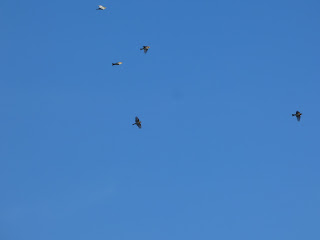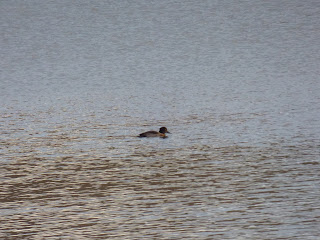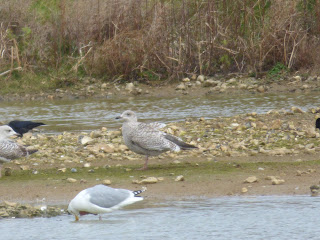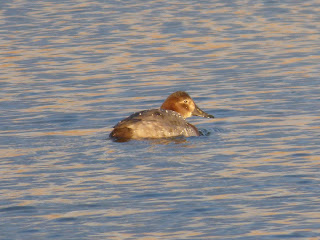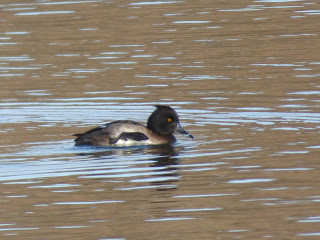Yesterday I met up with Ben Rumsby for a spot of birding at Rainham Marshes in Essex. Rain and strong winds were forecast for most of the day and conditions were tricky. Despite this, I still managed to get 66 species for the day with a lot of help from Ben, 7 of which were new for me at Rainham - taking me from 96 species to 103 (not bad considering how infrequently visit).
The day started well. Before Ben arrived I decided to walk along the river to Aveley Bay in the hopes of seeing a few flocks of waders. Almost instantly I heard 2 Rock Pipit calling and picked them up in flight as they went further along the river bank. They were my first ever Rock Pipits at Rainham (that I have been able to identify) and a welcome sight considering how few records there are each year at Beddington. A bit further along the river wall a Curlew showed nicely and 18 Shelduck were out in the bay. Several Teal and Wigeon had also collected on the Thames, whilst a few Common Gulls and Great Black-backed Gulls flew west. Wigeon are annual but scarce at Beddington and numbers are never very high, whilst large numbers of Teal are mostly hidden from public view. Over 1,000 Lapwing erupted into the air over the reserve, which was clearly the impact of a bird of prey. It didn't take long to find that a female Peregrine had caused the mass panic - a first for me at Rainham. About 10 minutes later a male had taken over and a Marsh Harrier added to the chaos. However, after scanning and being rather disappointed by the absence of any Black-tailed Godwits or Avocets in Aveley Bay, I turned around to head towards the Visitor Centre where I planned to meet Ben. About half way back a flock of 5 Redshank called loudly as they took off from the river bank, whilst 3 Dunlin burst over to the Kent side (another Rainham first for me).
 |
| Curlew |
 |
| Male Wigeon |
 |
| Lapwings |
 |
| Female Peregrine |
 |
| Redshank |
After meeting at the Visitor Centre, we made hasty progress around the reserve. Not much of particular interest was about and we were heading towards where the long-staying Spoonbill had been regularly seen. Before we even got there, we spotted the Spoonbill (my 4th Rainham tick of the day already and species 100!) in flight as it dropped down onto a part of the reserve that we would struggle to view from the upcoming hide. Nonetheless, it was a decent view and it's only my 3rd ever Spoonbill anywhere. Once we got to the Shooting Butts hide, a Water Pipit showed well - far better than the often fleeting views back at Beddington - in front of a Common Snipe. Several more Snipe were spotted whilst scanning along the edge, but sadly none could be morphed into a Jack Snipe.
Rainham is still the only place I have ever seen Ruff, but unfortunately the two that had recently been seen were not present on Target Pools when we got there. There were also no Avocets or Godwits, so we quickly moved on and headed off towards Serin Mound. Being my first time up there, I was impressed by the views it provided over the reserve. However, the 5 Barnacle Geese that have been staying on Wennington sadly were not seen. We then headed back to the Visitor Centre for midday. More Redshank and Dunlin flew out from the reserve towards the river.
We stayed for a good two and a half hours in the centre before Ben left. Whilst there, a Fieldfare and a couple of Redwing occupied the ground around the feeders, whilst a pair of Long-tailed Tits and some Chaffinch fed above them. Curlews flew close to the windows as they went out to the river to feed. Ben managed to pick out an adult Mediterranean Gull flying east along the far bank of the river. That put me up to 5 new Rainham birds for the day. The Spoonbill had also decided to go over to the far river bank. Ben also spotted an Oystercatcher (my 6th Rainham tick) and 4 Avocet swimming on the river. I also finally met Howard Vaughan for the first time - an excellent birder and naturalist that helps out at Rainham a lot. I had heard good things about him from other young birders already. We chatted for a while about different birding experiences and he shared some of his knowledge too. Ben then left at 14:30 and I headed back out into the rain to do one more circuit around the reserve before heading home.
A quick stop in the Purfleet hide provided nice views of a drake Pintail. Beddington had no male Pintail last year so I enjoyed watching this stunning duck. A couple of Redshank also put on a show by flying and calling close to the hide. The walk from there to Target Pools provided good views of a female-type Marsh Harrier, a male Pheasant, and quick glimpse of a calling Bearded Tit. There were still no waders on Target Pools, except for about 10 Lapwing. However, I managed to pick up an adult Yellow-legged Gull flying straight towards me. On the way back to the Visitor Centre, I managed to get a male Firecrest nice and close, which was an excellent way to finish the day as it was another first for me at Rainham.
Redshank sound recording:
 |
| Male Pheasant |
 |
| Record shot of the male Firecrest in the fading light of what was already a dark and grey day |
Firecrest sound recordings:
An excellent day overall (full Ebird list here) and I look forward to visiting again at some point in the not too distant future. Perhaps a day during spring migration might be a plan?




